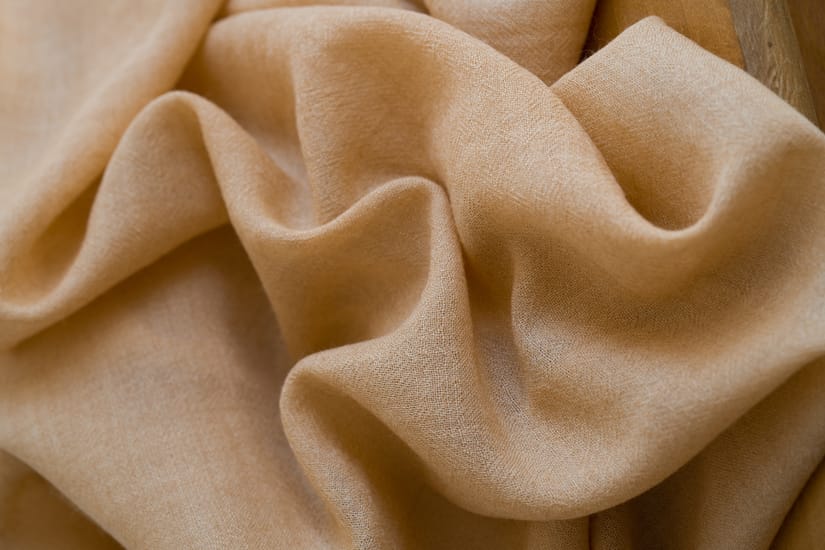Zeefier is a Dutch startup located in the Hague,
the largest city in the Netherlands near by the sea. A company established by Nienke Hoogvliet and Anne Boermans is on a mission of co-creating a cleaner fashion industry. They work on achieving it through research and development of natural dyes for textiles made out of seaweed - “one of the most sustainable raw materials available”.
Nienke Hoogvliet (the creative co-founder of Zeefier) is a Dutch designer and artivist with a vast experience of working with natural dyes and colours made from plants, herbs and seaweed. In autumn 2021, she presented to the world her new project - a startup on a mission to manufacture dyes made from 100% natural seaweed.
The subtle, soothing but rich colour palette of textiles swatches dyed with seaweed, for the first time was presented during the latest edition of Dutch Design Week in Eindhoven. And even though the approach is innovative for the broader public, Nienke has a long established relationship with this great raw material, since she started working with seaweed already in 2014, with an attempt at developing textiles. Triggered by the unfolding potential of collected samples she asked “if plants can be used to make dyes, why can’t seaweed?” And just like that, driven by curiosity and need for cleaning the textile industry, for the past 8 years, Nienke elevated her research and created “the perfect recipe for artisanal and circular textile dyes from seaweed”.
Now, together with Anne and a team of experts, Zeefier was created to work on upscaling the processes to make their dyes available to the entire industry.
Few weeks after their new colour palette premiere, we reached out to Zeefier in order to learn more about their approach to colour and sustainability. This time we had a pleasure to talk to the business co-founder - Anne Boermans who brings to the team years of experience in business-building, marketing communication as well as advocating for blue economy practises. Anne shared with us insights on values behind this particular colour development as well as information about services their company offers.

Photo credits: Zeefier
AoSC: What is the mission behind your work?
AB: We envision a world where our seaweed dyes are the new standard. Our dyes are locally produced from seaweed waste streams with respect to our surroundings, our workers, and clients. By making a quality product providing to the industry’s needs, we can replace the harmful synthetic dyes that are now often used. We are a pioneer in the textile industry, proving that creating a sustainable product doesn’t mean compromising on quality. We raise awareness by being a role model of a holistic, innovative, transparent, and financially successful business. We want to colour the world with our seaweed textile dyes
Nienke’s work was always driven by a dream of being a force behind a radical change in the textile industry. Zeefier in that case is the personification of making this dream real and putting words into action, elevating artisanal methods to solve industry issues. What is more, there is a very simple and beautiful connection to locality and heritage, enchanted in the company’s name - ”Phonetically, Zephyr is pronounced in Dutch sound as ‘zee’ and ‘fier’, meaning ‘sea’ and ‘proud’. Being a Dutch initiative, Zeefier is proud of all the beauty the waters of the Netherlands have to offer.”
AoSC: What is sustainable in the Zeefier colours?
AB:“Our dyes are 100% natural seaweed dyes for textiles”
To understand better sustainability of Zeefier’s innovative colouring approach it is important to bring more facts about seaweed itself - the macroalgae which can be seen at the sea shore with the naked eye. It is a raw material with one of the lowest impacts because it grows without need for freshwater, agricultural land or chemicals. Additionally it produces oxygen and purifies CO2.
AoSC: Where does your dyestuff come from?
AB: To source colour’s raw material, Zeefier works with seaweed suppliers, both from the Netherlands and abroad. The usage of seaweed is popular across other industries such as food or cosmetics, and those industries' waste streams become the source of raw material which Zeefier uses for their dyes. We are working with seaweed and its waste streams.
Recognizing the circular potential of seaweed, the brand turns the waste into one of a kind colours for textiles, being an example of the cleaner colour producer through and thanks to embracing the circular economy approach.
AoSC: What are the materials you can dye? Do you work with all kinds of fabrics?
AB: With our dyes you can dye textiles, yarns, and whole garments. We work for both textile producers as well as brands and designers from the interior and fashion market.
AoSC: What stage of growth are you in?
AB: As a start-up we keep looking for more funding opportunities. We work with our first clients and we are open for more projects and inquiries.
AoSC: What is your timeline while dyeing textiles?
AB: The time and process depends on the individual client and inquiry.
AoSC: What challenges or barriers are you facing currently?
AB: Developing your own, unique approach to colour for textiles brings up questions about colour naming, referencing and systematising. Natural, seaweed base colours are unique, and no one else has the formula to reproduce it. Besides that, pandemic reality enforced cancellation of events which were the opportunity to showcase the colour on tactile swatches. It is important to create an opportunity for people to see physical samples dyed with seaweed to learn about the range of colours and possibilities. Additionally, often we get requests from our clients to dye their fabric so we need to create those samples on demand, as each fibre can unfold new colour expressions. That of course requires time.
AoSC: What colours shall we imagine while talking about seaweed-based colour palette?
AB:Our colour palette ranges from orange, yellow, brown, green, beige, pink, purple, grey.
AoSC: What do you find the most challenging while working at the intersection of (your field) and the textile industry?
AB: As a company we mainly position ourselves as a dye supplier but next to that we also dye special fabrics like local wools and linen for clients. We also get requests to dye textiles and garments for clients.
AoSC: What needs to happen in order to bring this vision to life?
Designers and consumers buying our dyes and fabrics.
AoSC: What is your favourite colour?
All the seaweed dyed colours are my favourite!

Photo credits: Zeefier
colour source: seaweed
method: natural dyeing
using other industries wastestreams
the Hague, the Netherlands
STARTUP NATURAL TEXTILE DYER